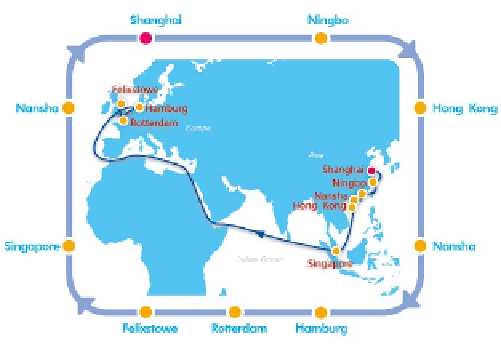Information Technology Reference
In-Depth Information
When
=0,
=0, which means there is no CO
2
emissions cost. When
=1,
=0, there is CO
2
auction cost, but no purchase cost. When
=1,
=1, there are CO
2
auction and purchase costs.
4
Case Study
This paper takes an international liner route, i.e., Asia to North Europe, as an example
to evaluate the influence of the marine emissions trading scheme on the annual profit
of a ship. There are three reasons for the choice of this route. At first, it is one of the
typical shipping lines for international containerships. Moreover, one end of this ship-
ping line is Europe, which is active in the marine emissions trading scheme. Fig.1
shows the explicit information of the route.
Fig. 1.
Shipping Route for the Case Study (Source: China Ocean Shipping (Group) Company)
We assume a containership operating in this line with a capacity of 8000 TEUs. Its
design speed is 24.1 knots and the corresponding main engine fuel consumption is
11.9 tons/h. Hence, the main engine maximum daily fuel consumption (
MF
) is 285.6
tons. Its auxiliary engine fuel consumption is 2 tons/day at sea and 1 ton/day in port.
In general, trips of the Asia to north Europe route are differentiated by westbound and
eastbound. For the case study in this paper, westbound means a voyage from Shang-
hai to Felixstowe. On the contrary, eastbound is a trip from Felixstowe back to

